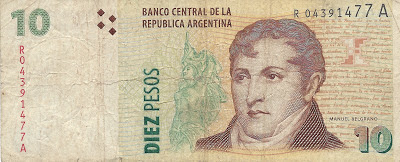When I was in Buenos
Aires in late November, I was running short of US dollars to turn into
Argentine pesos on the so-called “blue”
market, which had made my stay there considerably cheaper than it would
have been at the official rate. I had, however, planned a brief trip to
Uruguay, whose ATMs would yield the dollars I needed to get me through the rest
of my stay in Argentina.
After taking the Buquebús
ferry from Buenos Aires, I spent three nights in Colonia, twice
hitting local ATMs for the maximum withdrawal of $300 to get me through my
remaining weeks. Unlike Argentina, where the option to withdraw US dollars
disappeared some time ago, Uruguay has no restrictions on such withdrawals,
other than the daily maximum.
Argentines, in fact, cannot use their own ATM cards outside
their borders but, being resourceful, they’ve found a way around the dollar
restrictions by taking cash advances on their credit cards. Since the Argentine
government has recently levied a 20 percent tax on credit card transactions by
its citizens traveling abroad, those cash advances exceed the official rate
within Argentina.
That’s pretty irrelevant, though, when the government has
made it difficult or impossible to purchase dollars without jumping through the
taxman’s hoops. Imagine the howls if the Internal Revenue Service demanded US
citizens prove their creditworthiness before traveling overseas, and it’s clear
why many Argentines will do most anything to purchase dollars to protect their
savings in an inflationary economy.
To do so, individual Argentines have been taking the ferry
to Colonia, but not necessarily for themselves alone. Rather, groups of friends
and neighbors have been “loaning” their MasterCard and Visa to each other for
raids on Uruguayan ATMs – an individual will take the first morning ferry
across the River Plate and then hit the banks, withdrawing as much as possible
for themselves and their friends. They return to Buenos Aires on the afternoon
boat, having presumably limited their total acquisitions to less than
US$10,000, to avoid having to make a legal declaration.
Today, the Argentina peso’s official rate was 5.235 to the
dollar and, with the 20 percent tax, Argentines who cross the river are paying
approximately 6.3 pesos for each dollar. On
the open market, though, the “blue” dollar recently rose above 10 before receding
under government pressure on the quasi-legal cuevas (caves) that sell dollars
semi-surreptitiously. Today the “blue” closed just above nine pesos, but that
means that those taking advantage of Colonia ATMs still come out about 30
percent ahead.
For Uruguayans and non-Argentine visitors to Colonia,
though, this has been a headache because the long lines of Argentines have made
it difficult for them to obtain Uruguayan currency, let alone dollars. The
lines at Colonia’s ATMs can be dozens deep and, with many Argentines
undertaking multiple transactions, the machines empty quickly. According
to Uruguay’s outspoken president José Mujica, who’s had his differences
with the government of Argentina’s Cristina
Fernández de Kirchner, “The Argentines have always been in a rush to keep
their savings in dollars, because they don’t trust their own currency…”
Until the situation resolves itself, which doesn’t seem likely
in the short run, Uruguay-bound visitors should be aware of the situation in
Colonia and, if possible, try to hit the ATMs early in the morning, before the
Argentines arrive. It’s not such an issue in Montevideo, as the Uruguayan
capital has many more banks, and is three hours from Buenos Aires rather than
Colonia’s one hour. For those crossing the river only to acquire dollars, the
ferry ticket to Montevideo is more expensive in both time and money.
Moon
Handbooks Chile, in Saratoga
In a little more than a month – Monday, June 17, at 7 p.m.,
to be precise – I will offer a digital slide presentation on travel in Chile at
Santa Clara Country’s Saratoga Library (13650
Saratoga Avenue, Saratoga CA 95070, tel. 408-867-6126, ext. 3817). Coverage will also include
the Chilean Pacific Islands of Rapa
Nui (Easter Island) and Juan
Fernández (Robinson Crusoe), as well as southernmost Argentina
(Tierra
del Fuego and the vicinity of El
Calafate) that appear in the book. I will also be available to answer
questions about Argentina and Buenos
Aires. The presentation is free of charge, but books will be available for
purchase.
















